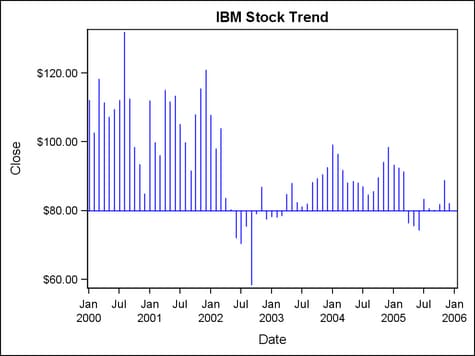Example Program and Statement Details
Example Program
proc template;
define statgraph needleplot;
begingraph;
entrytitle "IBM Stock Trend";
layout overlay;
needleplot x=date y=close /
baselineintercept=80 lineattrs=(color=blue);
endlayout;
endgraph;
end;
run;
proc sgrender data=sashelp.stocks template=needleplot;
where stock="IBM" and date > "31dec1999"d;
run;
Options
specifies the color
and font attributes of the data labels. See General Syntax for Attribute Options for the syntax
on using a style-element and Text Options for available text-options.
creates a distinct
set of needles, markers, and data labels for each unique group value
of the specified column.
Default: Each distinct group value might be represented in the graph by a
different combination of color, line pattern, and marker symbol. These
vary according to the ContrastColor, LineStyle, and MarkerSymbol attributes
of the GraphData1 - GraphDataN style elements.
Interaction: The group values are mapped in the order of the data, unless the INDEX= option is used to alter the default sequence
of marker symbols, colors, and line patterns.
The representations
that are used to identify the groups can be overridden. For example,
each distinct group value might be represented by a different line
pattern, but the LINEATTRS= ( PATTERN=pattern ) option could be used to assign the same line pattern to all of
the plot’s line patterns, letting line color indicate group
values. Likewise, LINEATTRS= ( COLOR= color ) could be used to assign the same color to all lines, letting line
pattern indicate group values.
specifies indices for
mapping needle attributes (color, marker symbol, and line pattern)
to one of the GraphData1 - GranphDataN style elements.
Interaction: All of the indexes for a specific group value must be the same.
Otherwise, the results are unpredictable.
Interaction: The index values are 1-based indices. For the style elements in
GraphData1 - GraphDataN, if the index value is greater than N, then
a modulo operation remaps that index value to a number less than N
to determine which style element to use.
Discussion: Indexing can be used to collapse the number of groups that are represented
in a graph. For more information, see Remapping Groups for Grouped Data.
specifies the attributes
of the needles for the data points. See General Syntax for Attribute Options for the syntax
on using a style-element and Line Options for available line-options.
specifies the attributes
of the data markers. See General Syntax for Attribute Options for the syntax
on using a style-element and Marker Options for available marker-options.
specifies that the
data columns for this plot be used for determining default axis features.
Details: This option is needed only when two or more plots within an overlay-type
layout contribute to a common axis. For more information, see When Plots Share Data and a Common Axis
specifies user-defined
roles for information contained in data columns.
Requirement: The role names that you choose must be unique and different from
the pre-defined roles X, Y, DATALABEL, INDEX, and GROUP.
This option provides
a way to add to the data columns that appear in tooltips specified
by the TIP= option.
specifies the information
to display when the cursor is positioned over a needle line or marker.
If this option is used, it replaces all the information displayed
by default. Roles for columns that do not contribute to the needle
plot can be specified along with roles that do.
Default: The columns assigned to these roles are automatically included in
the tooltip information: X, Y, DATALABEL, and GROUP.
an ordered, blank-separated
list of unique NEEDLEPLOT and user-defined roles. NEEDLEPLOT roles
include X, Y, DATALABEL, and GROUP.
User-defined roles
are defined with the ROLENAME= option.
Requirement: To generate tooltips, you must include an ODS GRAPHICS ON statement
that has the IMAGEMAP option specified, and write the graphs to the
ODS HTML destination.
Interaction: The labels and formats for the TIP variables can be controlled with
the TIPLABEL= and TIPFORMAT= options.
specifies display formats
for tip columns.
Default: The column format of the variable assigned to the role or BEST6.
if no format is assigned to a numeric column.
Requirement: This option provides a way to control the formats of columns that
appear in tooltips. Only the roles that appear in the TIP= option
are used. Columns must be assigned to the roles for this option to
have any effect. See the ROLENAME= option.
specifies display labels
for tip columns.
Requirement: This option provides a way to control the labels of columns that
appear in tooltips. Only the roles that appear in the TIP= option
are used. Columns must be assigned to the roles for this option to
have any effect. See the ROLENAME= option.
specifies whether data
are mapped to the primary X (bottom) axis or to the secondary X2 (top)
axis.
Interaction: The overall plot specification and the layout type determine the
axis display. For more information, see How Axis Features are Determined.
specifies whether data
are mapped to the primary Y (left) axis or to the secondary Y2 (right)
axis.
Interaction: The overall plot specification and the layout type determine the
axis display. For more information, see How Axis Features are Determined.
